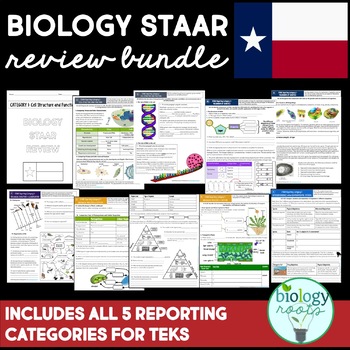STAAR Biology Review Bundle
What educators are saying
Products in this Bundle (5)
Description
This review tool for the STAAR EOC Biology exam (State of Texas Assessment of Academic Readiness) covers all readiness and supporting TEKS for Reporting Categories 1 through 5.
If you do not teach in Texas, you may be interested in my General Biology EOC Review.
Category 1: Cell Structure and Function (+Organism growth and cell differentiation)
TEKS B.4 and B.5 are included and clearly outlined.
2 pages- Compare and Contrast Prokaryotic and Eukaryotic cells
2 pages- Investigate and Explain Cellular Processes, Including Homeostasis and Transport of Molecules
3 pages- Compare the structure of viruses to cells, describe viral reproduction, and describe the role of viruses in causing diseases such as HIV and influenza.
2 pages- Describe the stages of the cell cycle including deoxyribonucleic acid (DNA) replication and mitosis, and the importance of the cell cycle to the growth of organisms.
2 pages- Describe the roles of deoxyribonucleic acid (DNA, ribonucleic acid (RNA), and environmental roles in cell differentiation.
2 pages- Recognize that disruptions of the cell cycle lead to diseases such as cancer
Category 2: Mechanisms of Genetics
TEKS B.6 included and clearly outlined.
2 pages- Identify components of DNA, identify how information for specifying the traits of an organism is carried in the DNA, and examine scientific explanations for the origin of DNA.
1 page- Recognize that components that make up the genetic code are common to all organisms.
2 pages- Explain the purpose of transcription and translation using models of DNA and RNA
2 pages- Recognize that gene expression is a regulated process.
2 pages- Identify and illustrate changes in DNA and evaluate the significance of these changes.
2 pages- Predict possible outcomes of genetic combinations such as monohybrid crosses, dihybrid crosses, and non-Mendelian inheritance.
2 pages- Recognize the significance of meiosis to sexual reproduction.
Category 3: Evolution and Classification (Evolutionary Theory and Taxonomy of Organisms)
TEKS B.7 and B.8 included and clearly outlined.
3 pages- B.7 (A) Analyze and evaluate how evidence of common ancestry among groups is provided by the fossil record, biogeography, and homologies, including anatomical, molecular and development.
1 page- B.7 (B) Examine scientific explanations of abrupt appearance and stasis in the fossil record
2 pages- B.7 (C) Analyze and evaluate how natural selection produces change in populations, not individuals
2 pages- B.7 (D) Analyze and evaluate how the elements of natural selection, including inherited variation, the potential to produce more offspring than can survive, and a finite supply of resources, result in differential reproductive success.
2 pages- B.7 (E) Analyze and evaluate the relationship of natural selection to the adaptation and to the development of diversity in and among species.
2 pages- B.7 (F) Analyze other evolutionary mechanisms, including genetic drift, gene flow, mutation, and recombination.
1 page- B.8 (A) Define taxonomy and recognize the importance of a standardized taxonomic system to the scientific community.
2 pages- B.8 (B) Categorize organisms using a hierarchical classification system based on similarities and differences
1 page- B.8 (C) Compare characteristics of taxonomic groups, including archaea, bacteria, fungi, plants, and animals
Category 4: Biological Processes and Systems (Molecules and Levels of Biological Systems)
TEKS B.9 and B.10 included and clearly outlined.
2 pages- B.9 (A) Compare the functions of different types of biomolecules, including carbohydrates, lipids, proteins and nucleic acids
2 pages- B.9 (B) Compare the reactants and products of photosynthesis and cellular respiration in terms of energy, energy conversions, and matter.
2 pages- B.9 (C) Identify and investigate the role of enzymes.
3 pages- B.10 (A) Describe the interactions that occur among systems that perform the functions of regulation, nutrient absorption, reproduction, and defense from injury or illness in animals.
3 pages- B.10 (B) Describe the interactions that occur among systems that perform the functions of transport, reproduction, and response in plants.
1 page- B.10 (C) Analyze the levels of organization in biological systems and relate the levels to each other and to the whole system.
Category 5: Interdependence Within Environmental Systems (Ecological Succession and Organism Behavior)
TEKS B.11 and B.12 included and clearly outlined.
1 page- B.11 (A) Summarize the role of microorganisms in both maintaining and disrupting the health of both ecosystems and organisms.
2 pages- B.11 (B) Describe how event and processes that occur during ecological succession can change populations and species diversity.
2 pages- B.12 (A) Interpret relationships, including predation, parasitism, commensalism, mutualism, and competition among organisms.
1 page-B.12 (B) Compare variations and adaptations of organisms in different ecosystems
2 pages- B.12 (C) Analyze the flow of matter and energy through trophic levels using various models, including food chains, food webs, and ecological pyramids.
2 pages- B.12 (D) Describe the flow of matter through the carbon and nitrogen cycles and explain the consequence of disrupting these cycles.
2 pages- B.12 (E) Describe how environmental change can impact ecosystem stability.
Optional cover page to make a booklet.
An alternate version is available that has guided answers.
Black and white versions included.
Answer key is included.
Vanessa Jason Biology Roots
For single classroom only; not to be shared publicly (do not create publicly accessible links).
Copying for more than one teacher, classroom, department, school, or district is prohibited. Failure to comply is a violation of the DMCA (Digital Millennium Copyright Act).
☆☆Follow me on☆☆


